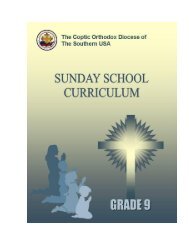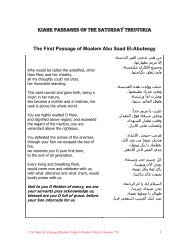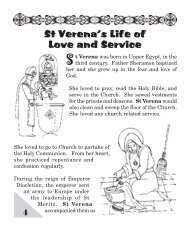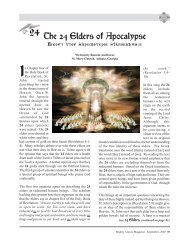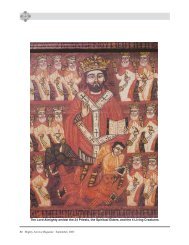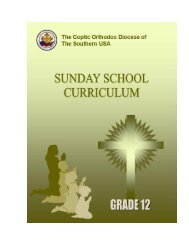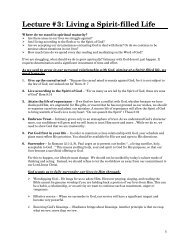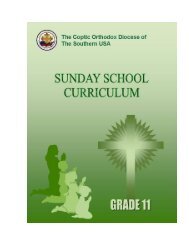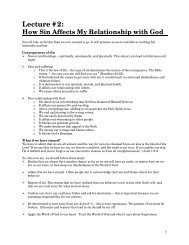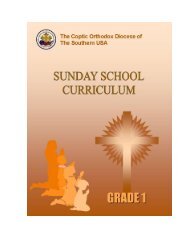Grade 10 - Coptic Orthodox Diocese of the Southern United States
Grade 10 - Coptic Orthodox Diocese of the Southern United States
Grade 10 - Coptic Orthodox Diocese of the Southern United States
You also want an ePaper? Increase the reach of your titles
YUMPU automatically turns print PDFs into web optimized ePapers that Google loves.
Sunday School Curriculum <strong>Grade</strong> <strong>10</strong><br />
A woman looking for a lost coin illustrates <strong>the</strong> concern <strong>of</strong> God for lost sinners (Luke 15:8-<strong>10</strong>).<br />
The wise and foolish bridesmaids are examples <strong>of</strong> <strong>the</strong> need for everyone to be prepared for <strong>the</strong><br />
unexpected moment <strong>of</strong> Christ‘s return (Mat<strong>the</strong>w 25:1-13). A woman appears in a parable to<br />
illustrate an aspect <strong>of</strong> <strong>the</strong> Kingdom <strong>of</strong> God such as perseverance in prayer (Luke 18:1-8).<br />
Jesus <strong>of</strong>ten refers to women in <strong>the</strong>se parables and sayings always in a positive way.<br />
Women were not only recipients <strong>of</strong> <strong>the</strong> Lord‘s ministry. St. Luke reveals that Jesus on<br />
numerous occasions gladly received <strong>the</strong> help and ministry <strong>of</strong> women (Luke 8:1-3). St. Mark<br />
attests that some women followed Jesus when He was preaching in Galilee (Mark 15:40-41).<br />
Women were a part <strong>of</strong> His close circle <strong>of</strong> friends and companions.<br />
Women in <strong>the</strong> Early Church<br />
In Romans chapter 16, St. Paul greets some <strong>of</strong> <strong>the</strong>se women by name and acknowledge <strong>the</strong>ir<br />
important contributions to <strong>the</strong> life and growth <strong>of</strong> <strong>the</strong> church. Priscilla is a woman who<br />
receives particular mention. In Acts she is engaged with her husband, Aquila, in teaching <strong>the</strong><br />
great orator Apollos. Paul‘s reference to <strong>the</strong> couple as ―fellow workers‖ is to be noted. After,<br />
Priscilla and Aquila, Paul greets still o<strong>the</strong>r women: Mary, Tryphaena, Tryphosa, and Persis,<br />
all <strong>of</strong> <strong>the</strong> women ―worked hard‖ in <strong>the</strong> Lord‘s word. Also he greets <strong>the</strong> mo<strong>the</strong>r <strong>of</strong> Rufs and<br />
sister Nereus (Romans. 16:13,15). In Philippians 4:2-3, he mentions two o<strong>the</strong>r women, Euodia<br />
and Synthche, who have labored beside him in <strong>the</strong> gospel. Although it is impossible to<br />
determine from St. Paul‘s words what specific missionary tasks <strong>the</strong>se women assumed, <strong>the</strong>re<br />
is no doubt that he <strong>of</strong>ten benefited from <strong>the</strong> cooperation <strong>of</strong> women in his apostolic labors and<br />
that women were no less active than men in spreading <strong>the</strong> gospel‘s message. The early<br />
Christian churches followed <strong>the</strong> pattern established by Jesus <strong>of</strong> including women as integral<br />
members. They attended worship, participated vocally, were instructed, learned <strong>of</strong> <strong>the</strong> faith<br />
and shared it with o<strong>the</strong>rs (Acts 1:14).<br />
They also played a significant role in <strong>the</strong> life <strong>of</strong> <strong>the</strong> community, teaching men and women and<br />
caring for those in need. Within <strong>the</strong> ―<strong>of</strong>ficial‖ ordering <strong>of</strong> <strong>the</strong> early church‘s life <strong>the</strong>re were<br />
two primary orders <strong>of</strong> women: Widows and Deaconesses. Widows were recipients <strong>of</strong> <strong>the</strong><br />
church‘s charity in return for which <strong>the</strong>y were ―appointed for prayer‖ (1Timothy 5:3).<br />
Widows were a part <strong>of</strong> clerical orders and had a broad range <strong>of</strong> responsibilities such as<br />
teaching women, visiting <strong>the</strong> sick, and helping in various ways at <strong>the</strong> church. A deaconess<br />
was a very significant feature <strong>of</strong> <strong>the</strong> church within Greek and Syrian Christianity. The West<br />
did not have this position until <strong>the</strong> fifth century when <strong>the</strong>y reluctantly acquiesced. The outline<br />
<strong>of</strong> <strong>the</strong> activities <strong>of</strong> <strong>the</strong> deaconess can be discerned. They 1) assisted <strong>the</strong> bishop in <strong>the</strong> baptism<br />
<strong>of</strong> women, especially in <strong>the</strong> anointing <strong>of</strong> <strong>the</strong> body. 2) Assisted women who were in need or ill.<br />
3) Guarded <strong>the</strong> door by which women entered and left <strong>the</strong> assembly and ensured that <strong>the</strong><br />
younger women gave way to <strong>the</strong> older women in <strong>the</strong> place reserved for <strong>the</strong>m. 4) Verified <strong>the</strong><br />
corporal integrity <strong>of</strong> <strong>the</strong> virgins. 5) Bore messages and traveled about on congregational<br />
business.<br />
Concerning <strong>the</strong> role <strong>of</strong> women, <strong>the</strong>re is a general exclusion <strong>of</strong> <strong>the</strong>m from priestly duties and<br />
from public teaching. Never from <strong>the</strong> beginning <strong>of</strong> <strong>the</strong> world has a women served God as<br />
priest. Jesus chose to be baptized by John and He sent <strong>the</strong> twelve apostles for preaching. He<br />
has delivered to His church no indication <strong>of</strong> women priests because He ―knows <strong>the</strong> order <strong>of</strong><br />
creation‖ <strong>the</strong> man is <strong>the</strong> head <strong>of</strong> <strong>the</strong> woman and Christ is <strong>the</strong> head <strong>of</strong> <strong>the</strong> man. Jesus clearly<br />
shows His regard for women, created equally with men in <strong>the</strong> image and likeness <strong>of</strong> God. In<br />
order <strong>of</strong> creation, God has placed woman in a position subordinate to man. The Scriptural<br />
PENTECOST PERIOD 135



